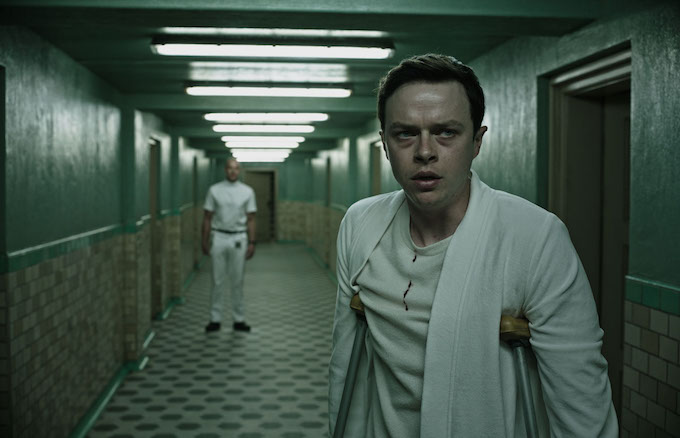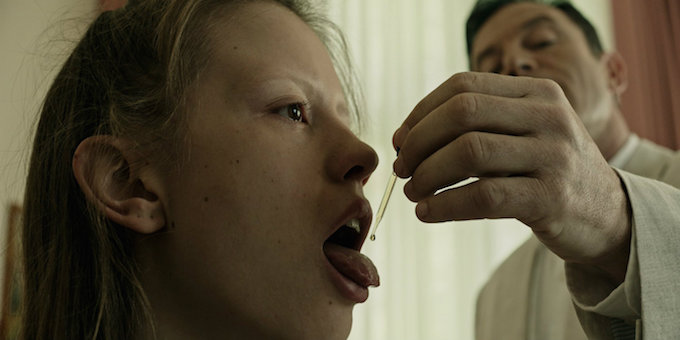A CURE FOR WELLNESS
 Wednesday, March 15, 2017 at 7:48AM
Wednesday, March 15, 2017 at 7:48AM Stars: Dane DeHann, Jason Isaacs, Mia Goth, Ivo Nandi, Adrian Schiller, Celia Imrie, Harry Groener, Tomas Norstrom, Ashok Mandanna and Magnus Krepper.
Writer: Justin Haythe.
Director: Gore Verbinski.
WARNING: CONTAINS SOME SPOILERS
Rating: 1.5/5

Reteaming with screenwriter Justin Haythe, the scribe who spewed out the notorious flop The Lone Ranger, lies somewhere in the middle of the list of bewilderingly bad decisions Gore Verbinski makes in his latest career-killer, A Cure for Wellness.
A groaningly pedestrian, chill-free, faux-Gothic head-scratcher that manages to be both convolutely labyrinthine and entirely pointless, the latest from The Pirates of the Caribbean director blathers on loudly and incoherently for two achingly uninteresting hours. The final 30 minutes (yes, it clocks in at an unforgivable 2½ hours) might have provided some unintentionally hilarious OTT entertainment value had it not revealed the darkly misogynistic heart that drives the pretentious ‘fountain-of-youth’ nonsense.
Once-hot Dane DeHaan carves a red line through his career trajectory as Wall Street douchebag Lockhart, an upwardly mobile young financial exec who agrees to head to a sanatorium in the Swiss Alps and recover the firm’s CEO, who has holed up in the centuries-old facility. Following a spectacularly staged car accident (a high-point, despite yet another awkwardly CGI-rendered reindeer), Lockhart soon finds himself confined within the walls of the hospital, an exuberantly over-designed facility whose cinematic qualities almost justify the entire films existence.
So begins a seemingly endless session of our protagonist hobbling through corridors and opening doors, having ambiguously meaningless conversations with elderly patients and getting into ponderous passages of ceaselessly dull dialogue with the administrator, Dr Volmer. This pointy-featured creep is provided a full repertoire of villainous tics and lip purses by Jason Isaacs, a career ham delivering a performance that may have proved a lot more fun had it served an equally self-deprecating master.

But A Cure for Wellness provides no such levity; Verbinski takes all the haughty melodrama, grand staging and occasionally gruesome flourishes as seriously as Shakespeare. Scenes extend beyond their natural flow with frustratingly inconsequential payoffs. Exploring a steam bath facility that begins to resemble a tiled version of the hedge maze in The Shining, Lockhart turns one corner…then another…then another; an off-limit section of the facility is similarly explored in boring detail, at a point in the narrative when tension should be building to a crescendo. The crux of the mystery that drives the film’s meagre momentum is so utterly lacking, it reveals all that has gone before to be little more than one red herring after another. Themes or subtext hinted at –memories of guilt, sins of the father, the curse of aging, and so on – are so underdeveloped as to not warrant consideration.
The reason the film deserves no break at all is the lecherous path charted for the sole female lead, Hannah. Played as a wispy early-teen innocent by 24 year-old Mia Goth, the character recalls Sissy Spacek’s virginal Carrie in her wide-eyed confusion about the onset of early womanhood. But unlike Carrie, who gets her own back via vengeful telekinesis, Hannah’s first cycle (horribly over-staged in a wading pool filled with Verbinski’s and Haythe’s ridiculously overused metaphor of choice, the eel) leads to violent disrobing and incestual rape, her small, naked breast centre-of-frame as she struggles to escape. There is no redemption for Hannah, unless one considers the role she plays in making her film’s hero look more heroic a sufficient character arc. It is an abhorrent gender representation that caps off one of the most distasteful and obnoxious studio offerings in recent memory.
 Gothic,
Gothic,  Supernatural,
Supernatural,  thriller
thriller 
